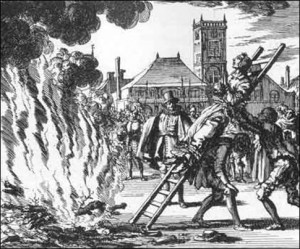1527 Anabaptist Michael Sattler condemned to death
Martin Luther’s belief that a vernacular scripture could only be read in one way by honest folk proved to be hopelessly naive and the 1520s saw the proliferation of a host of sects each claiming their version of Christianity was Biblically warranted. Among those were a group in Zürich who tried to reconstruct the church based on the behaviours they perceived in the Book of Acts. All true believers should be baptized as adults and not as children; they should espouse pacifism, abjure clerical celibacy, oaths and the devotions of the medieval church, choose their own pastors, and practise cultural separatism. These ideas marked them as dangerous radicals in the eyes of both Catholics and Protestants, resulting in intense persecution. Michael Sattler was one of the signatories to the Anabaptist Manifesto known as the “Schleichtheim Confession” of 1527.
On March 17, 1527 Sattler (an ex-monk), his wife (a former Beguine) and others were tried and condemned by authorities in Rottenburg, Germany. His punishment was ordered: “Michael Sattler shall be committed to the executioner. The latter shall take him to the square and there first cut out his tongue, and then forge him fast to a wagon and there with glowing iron tongs twice tear pieces from his body, then on the way to the site of execution five times more as above and then burn his body to powder as an arch-heretic.” Despite his mutilation Sattler was able to proclaim at the stake: “Almighty, eternal God, thou art the way and the truth; because I have not been shown to be in error, I will with thy help on this day testify to the truth and seal it with my blood.” A bag of gunpowder had mercifully been hung from his neck and exploded when the flames reached it. His wife was punished by a “third baptism”: she was drowned.
